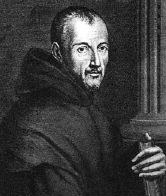

Marin Mersenne attended school at the College of Mans, Then, starting in 1604, he spent five years in the Jesuit College at La Fleche. From 1609 to 1611 he
studied theology at the Sorbonne.
Mersenne joined the religious order of the Minims in 1611. The name of the order comes since the Minims regard themselves as the least of all
the religious; they devote themselves to prayer, study and scholarship. Mersenne continued his education within the order at Nigeon and then at Meaux.
He returned to Paris where in 1612 he became a priest at the Place Royale.
He taught philosophy at the Minim convent at Nevers from 1614 to 1618. In 1619 he returned again to Paris. His cell in Paris became a meeting place for Fermat, Pascal, Gassendi, Roberval, Beaugrand and others who later became the core of the French
Academy. Mersenne corresponded with other eminent mathematicians and he played a major role in communicating mathematical knowledge throughout
Europe at a time when there were no scientific journals.
Mersenne investigated prime numbers and he tried to find a formula that would represent all primes. Although he failed in this, his work on numbers of
the form 2p – 1, where p is prime has been of continuing interest in the investigation of large primes.
It is easy to prove that if the number n = 2p – 1 is prime then p must be a prime. In 1644 Mersenne claimed that n is prime if p = 2, 3, 5, 7, 13, 17, 19, 31, 67, 127 and 257 but composite for the other 44 primes smaller than 257.
Over the years it has been found that Mersenne was wrong about 5 of the primes. He listed two that did not lead to a prime (67 and 257) and missed three that did (61, 89, 107).
Mersenne defended Descartes and Galileo against theological criticism and struggled to expose the pseudo sciences of alchemy and astrology. He
continued some of Galileo's work in acoustics and stimulated some of Galileo's own later discoveries. He proposed the use of the pendulum as a timing
device to Huygens, thus inspiring the first pendulum clock.
In the 1630's, Mersenne published translations of Galileo's lectures
on mechanics. It is through Mersenne that Galileo's work became known outside Italy.
He also published works in mathematical physics, and on music, musical instruments and acoustics.
After his death letters in his cell were found from 78 different correspondents including Fermat, Huygens, Pell, Galileo and Torricelli.